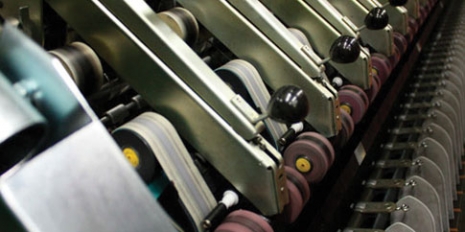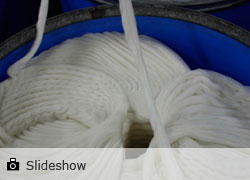
Loro Piana has been manufacturing fabrics for six generations and is currently the largest cashmere manufacturer in the world with a capacity of 4.5million metres per year. In 1999 the company progressed from being solely focused on producing fabrics to producing its own line of casual wear and accessories with the opening of the company’s first retail store in Milano.
Blog Part 3
The second day of our trip started with a site visit to the impressive Loro Piana Woollen Spinning Mill in Roccapietra (the first of two visits to Loro Piana’s set up in northern Italy). Like many of the mills in the area, Loro Piana was established here because of the soft and light quality of the water which is an important component for manufacturing superfine textiles with exceptional handle. In the early days the rivers in the region were also used turn the looms in the mill.
 To give you a brief overview on the company, Loro Piana has been manufacturing fabrics for six generations and is currently the largest cashmere manufacturer in the world with a capacity of 4.5million metres per year. In 1999 the company progressed from being solely focused on producing fabrics to producing its own line of casual wear and accessories with the opening of the company’s first retail store in Milano.
To give you a brief overview on the company, Loro Piana has been manufacturing fabrics for six generations and is currently the largest cashmere manufacturer in the world with a capacity of 4.5million metres per year. In 1999 the company progressed from being solely focused on producing fabrics to producing its own line of casual wear and accessories with the opening of the company’s first retail store in Milano.
Today, Loro Piana branded garments are sold through 119 retail stores throughout the world and the company manages six manufacturing operations (Quarona, Valduggia, Borgosesia, Ghemme, Roccapietra, and Sillavengo).
The company’s mission statement is to produce the highest quality products by sourcing the world’s finest and rarest raw materials. These materials include Angora, Camel, Cashmere, Vicuna and Merino. For those that don’t know, there are three wool fibre processing systems:
80% of woollen production at Loro Piana in Roccapietra was cashmere with merino making up most of the remaining 20%. We saw wool being processed through carding and spinning into single yarn. Because there is no combing stage with the woollen system, carding is very important to open and loosen the fibre for blending and for producing narrow ribbons of wool that are then rubbed to produce ‘slubbings’. Loro Piana has ten carding machines at this facility where the first cycle removes impurities, followed by a blending of the fibres before slubbing and spinning. Woollen spinning was a highlight as I saw for the first time yarn being made via the woollen system.
Woollen yarn was being spun at 500 turns per meter where 35 kilometres of slubbing creates 1kg of finished yarn.
It was also great to see the intensity of the Loro Piana testing programme which ensures they are using the finest quality fibres. One manual test to determine whether a fibre is cashmere can take approximately 6-7 hours each day.
Thanks to everyone at Loro Piana for taking the time to show us around. Grazie.
Comments
Post new comment